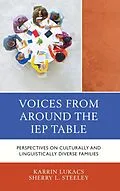When a group meets to discuss a student's Individualized Education Program (IEP), they are called a team, but they rarely understand the perspectives of the people with whom they are sitting at the table. This is especially true when cultural and linguistic diversity is part of the equation. This unique book explores the individual perspectives of IEP meeting participants who work with students who are culturally and linguistically diverse (CLD). Authors interviewed a principal, a general education teacher, a special education teacher, a teacher of English for Speakers of Other Languages (ESOL), an educational advocate, a disability rights attorney, a parent, a translator, a school psychologist, a specialist, a transition services specialist, and a guidance counselor. Their experiences provide critical insight for those seeking to realize the potential of these sometimes marginalized students. Interviews examined the dynamics of home-school communication, IEP meetings, and cross-cultural interactions. The perspectives shared in this book relate to known best practices and also provide practical suggestions for improving the experiences of teams serving the CLD population.
Autorentext
Karrin Lukacs is an award-winning Associate Professor of Curriculum and Instruction at Shenandoah University in Winchester, Virginia. Her research interests include teacher change agency, online learning, and stay-at-home mothers who want to become teachers.
Sherry L. Steeley is an Associate Teaching Professor at Georgetown University who works in ESL/EFL teacher education and international teacher education programs. Her research interests focus on teacher agency and identity, cultural transitions and school climate, and other issues related to equity and effectiveness in education.
Inhalt
Acknowledgments
Introduction
Chapter 1: The Principal's Voice
Chapter 2: The General Education Teacher's Voice
Chapter 3: The Special Education Teacher's Voice
Chapter 4: The ESOL Teacher's Voice
Chapter 5: The Advocate's Voice
Chapter 6: The Disability Rights Attorney Voice
Chapter 7: The Parent's Voice
Chapter 8: The Translator's Voice
Chapter 9: The School Psychologist's Voice
Chapter 10: The Specialist's Voice
Chapter 11: The Transition Services Specialist's Voice
Chapter 12: The Guidance Counselor's Voice
Conclusion
Appendix: Commonly Used Acronyms
References
About the Authors
